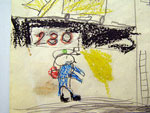BROWSE BY CATEGORY
- Archives and Libraries
- Blogs and Networking
- Bookmark This
- Digital Tools
- Examples of Teaching
- Exhibits
- Film Reviews
- History and Headlines
- Historic Sites and Museums
- Historical Thinking
- Holidays and Heritage
- Issues and Research
- Lesson Plans
- Material and Visual Culture
- Multimedia
- Organizations and Agencies
- Primary Sources
- Professional Development
- Publications
- Student Activities
- Teaching Materials
- Websites
Jennifer Orr on Making History Books

In the primary grades the focus on reading and writing is quite strong. Teaching other things often seems like an afterthought. As a 1st-grade teacher I’ve often addressed this by integrating other areas into our literacy time.
Writing books with first graders is something I greatly enjoy. It also happens to be an easy way to integrate history. We have written books about famous people, George Washington, Benjamin Franklin, or George Washington Carver; about the past in general (first graders work to understand the difference between the past and the present); and about the history of certain items (the Statue of Liberty, the Washington Monument) or holidays (the Fourth of July or Presidents’ Day).
We begin by learning as much as we can about the subject. I read books to my students, we listen to information on websites like pebblego, we watch videos, and we talk to each other about what we are learning. Often we will create a data retrieval chart to help organize all we are learning. If not a data retrieval chart, then we will organize through a web, sorting words, or phrases on cards. Preparing to write a book requires that we take time to reflect on what we have learned and organize the information.
Writing the book is the final activity for us, as a class, in the process of studying the topic. It’s a wonderful way to wrap up everything. The process of composing and writing helps solidify all we have learned.
First we take our organization (data retrieval chart, web, sorted cards) and review it. We take time to ensure we fully understand it all and decide how to order our book—where to begin and in which way to head. If we are writing about a person I will try to guide the students to plan the book in a chronological manner. Topics other than biographies are also guided, but with more freedom for the students. If they have a good reason for a plan for organizing the book we will do it. The discussions about how to order a book are valuable and deepen their understanding.
Once we have a plan we begin drafting. This process may take us several days. It is an opportunity to dig deeper into the history as we write as well as a chance to hone our writing skills. Together we compose our thoughts and create a book. We usually write our books as "big books." We use a large pad of paper to write together and the students illustrate when it is finished. That way we can add the big book to our collection and it can be read again and again throughout the year.
For more information
Do you teach older or technically-savvy students? Try having them make books online, instead of on paper!
High school teacher Joe Jelen shares ideas for creating e-books for and with students.
Learn about digital tools for creating books online and hardware tools for reading them in Tech for Teachers.
